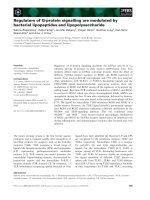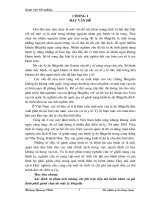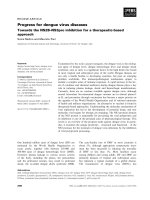FOODBORNE DISEASES SHIGELLA BACTERIA
Bạn đang xem bản rút gọn của tài liệu. Xem và tải ngay bản đầy đủ của tài liệu tại đây (539.03 KB, 10 trang )
MINISTRY OF EDUCATION AND TRAINING
NONG LAM UNIVERSITY – HO CHI MINH CITY
FACULTY: CHEMICAL ENGINEERING AND FOOD TECHNOLOGY
----
FOOD-BORN DISEASES
SHIGELLA BACTERIA
Student: BUI THIEN LOC
Major: Food Technology
Student ID: 18125170
Course: K44
Class: DH18TP
Instructor: Nguyen Hoang Nam Kha, PhD.
December 2021 - Ho Chi Minh city
1
I. Introduction
• Shigellosis is a form of bacterial diarrhea caused by gram-negative bacteria
Shigella species. The dysentery bacilli include four Shigella species, S.
dysenteriae, S. flexneri, S. sonnei, and S. boydii. It is common in
developing countries and results from contaminated food, poor sanitation
conditions, or direct person-to-person contact. The source of Shigella
contamination of food is mainly from raw materials, water, or processing
workers. Shigella can cause infection in all age groups. High-risk groups
include very young, elderly, and immunocompromised people.
• Detection methods for Shigella include conventional culture methods,
immunological methods, and molecular microbiological methods.
Molecular microbiological methods such as PCR (Shigella spp. can be
detected by PCR method based on the invasion plasmid antigen H(ipaH)
gene from food and fecal samples.), oligonucleotide microarrays, and repPCR have also been developed for the detection and identification of
Shigella.
• The reason why I choose Shigella bacteria is that it is an important human
pathogen besides E. coli that is responsible for most cases of endemic
bacillary dysentery, and it is also common in developing countries such as
Vietnam. In addition, Shigella is highly infectious and spreads very easily,
it takes just a small number of bacteria to make someone ill, and the very
young, the elderly, and the immunocompromised may even die from this
disease if not treated promptly.
II. Literature review
1) Detection of Shigella in lettuce by the use of a rapid molecular assay with
increased sensitivity by Jiménez, Kenia Barrantes McCoy, Clyde B Achí,
Rosario on the Brazilian Journal of Microbiology in 2010 (Jiménez et al.,
2010).
• What authors have done:
- Show that Multiplex Polymerase Chain Reaction (PCR) method have
many advantages compared to the conventional culture method in
detecting Shigella such as:
➢ Multiplex PCR detection limit was 104 CFU/ml, diagnostic
sensitivity and specificity were 100% accurate. Meanwhile, the
culture method detection limit was 106 CFU/ml, diagnostic
sensitivity was 53% and diagnostic specificity was 100%.
➢ Multiplex PCR detection produced results in 1 to 2 days while
the conventional culture method required 5 to 6 days.
➢ Multiplex PCR method for detection of virulence genes in
Shigella was shown to be effective in terms of diagnostic
1
2
sensitivity, detection limit, and amount of time as compared to
Shigella conventional culture.
• What authors have not done:
- The authors have not mentioned any disadvantages of Multiplex
Polymerase Chain Reaction (PCR) method compared to the
conventional culture method.
- Some disadvantages can be mentioned as: the cost for PCR method is
more expensive than the conventional culture method.
2) Anti-Shigella dysenteriae activity by probiotic lactic acid bacteria
(Pediococcus pentosaceus); an in vitro study by Srividya, D Prakash,
Shobha Dharmesh, Shylaja M Agrawal, Renu on The Journal of
Microbiology, Biotechnology and Food Sciences in 2015 (Srividya et al.,
2015).
• What authors have done:
- The authors pointed out that Probiotic Lactic acid Bacteria (PLB)
Pediococcus pentosaceus can be an effective natural agent against
Shigella-mediated infection.
- PLB lysate at 250 µg/mL protein concentration inhibited approximately
70% of Shigella dysenteriae growth in vitro.
- Red blood cells and buccal cells protection against the lysis induced by
Shigella dysenteriae lysate substantiated the cytoprotective role of PLB
- Regular intake of probiotic food supplements is beneficial in enteric
infections like shigellosis.
• What authors have not done:
- The authors have not given a specific amount of the daily intake of
probiotic food supplements to maintenance effectiveness against
Shigella bacteria.
- The authors have not stated whether stopping the use of probiotic food
supplements will still maintain the effectiveness of protection against
shigella bacteria.
3) Growing antimicrobial resistance of Shigella isolates by Shai Ashkenazi,
Itzhak Levy, Vered Kazaronovski, Zmira Samra on Journal of
Antimicrobial Chemotherapy in 2003 (Ashkenazi et al., 2003)
• What authors have done:
- The authors indicated that:
➢ The resistance of shigellosis to antimicrobial agents, namely
trimethoprim-sulfamethoxazole and ampicillin which is used to
treat shigellosis in young children, reached 94% and 85%,
respectively.
2
3
➢ The resistance of shigellosis to tetracycline, which is used in
children older than 7 years, increased from 23% to 87%.
➢ S. sonnei is currently significantly more resistant than the other
Shigella species in Israel, especially to the commonly used
antimicrobial agents.
➢ Physicians should be aware of the high antimicrobial resistance
rates of Shigella species, especially S. sonnei.
• What authors have not done:
- The authors have not yet provided a solution to this problem.
- Because resistance varies according to the specific location, continuous
local monitoring of resistance patterns is necessary for the appropriate
selection of empirical antimicrobial therapy.
4) Growth and Survival of Shigella flexneri in Common Bangladeshi Foods
under Various Conditions of Time and Temperature by M. S. Islam, M. K.
Hasan, and S. I. Khan on the Applied and Environmental Microbiology
journal in 1993 (Islam et al., 1993).
• What authors have done:
- The authors have shown that:
➢ Cooked rice, lentil soup, cooked fish, and similar dishes can act
as vehicles of Shigella infection.
➢ Wet foods such as milk and cooked wet rice (Pantha bhat), which
are frequently used as infant foods in Bangladesh, contribute to
the onset of acute diarrhea in children.
➢ S. flexneri in boiled rice and milk can undergo extensive
multiplication at 25 and 37°C and a population of > 108/g or ml
can be achieved within 6 to 18 hours.
➢ Utensils used in food preparation may also act as a source of
infection because S. sonnei could survive on metal utensils for
more than 2 to 28 days at 15°C and 0 to 13 days at 37°C.
➢ S. flexneri either showed a gradual decline or remained
unchanged in number when refrigerated at a temperature of 5°C.
➢ S. flexneri could survive in feces for 12 days at 25oC so flies may
also act as carriers of Shigella species from feces to foods left
uncovered. Thus, foods that were free of this infectious agent
may again become contaminated.
• What authors have not done:
- The authors have not mentioned much about the acid
adaptation/resistance in S. flexneri and the influence of pH on the
growth and survival of Shigella flexneri besides time and temperature
such as:
3
4
➢ S. flexneri can grow at temperatures ranging from 12 to 30oC at a
pH range of 5.0 – 7.3. The pathogen is able to survive longer at
4oC than at 12 to 48oC, regardless of pH (3.5 to 7.3) or prior
exposure to acidic environments.
- Acid adaptation in S. flexneri induces cross-protection against
temperature stress (48oC) and maybe an important mechanism
influencing survival in foods and in food processing environments.
5) Shigella infection in children under 5 years old in western French Guiana
by M. Parisot, N. Parez, R. Boukhari, S. Breurec and A. Jolivet on
Epidemiology and Infection in 2018 (Parisot et al., 2018).
• What authors have done:
- Pointed out that shigellosis is a frequent cause of diarrhea among
children under 5 years of age, especially among children under 1 year
of age. Similar to other developing countries, the main species isolated
was S. flexneri, and serotype 2a was highly represented.
- Confirms the usefulness of fluoroquinolones and third-generation
cephalosporin antibiotics in the treatment of shigellosis.
- The authors have shown that the seasonal peak of shigellosis coincided
with the warm and dry season.
• What authors have not done:
- The authors have not given a reason why children under 5 years of age,
especially those under 1 year of age, are the most common group to get
diarrhea caused by shigellosis.
- The authors have not yet provided a way to prevent or reduce Shigella
infection for children under 5 years of age.
6) Acid and base resistance in Escherichia coli and Shigella flexneri: role of
rpoS and growth pH on Journal of bacteriology Pam Small, Darcy
Blankenhorn, Diane Welty, Erik Zinser, and Joan L. Slonczewski in 1994
(Small et al., 1994).
• What authors have done:
- They have shown:
➢ rpoS is required for extreme acid resistance in aerobic cultures of
E. coli and S. flexneri and for base resistance in E. coli.
➢ Shigella flexneri grown to stationary phase can survive several
hours at pH 2 to 3, which is considerably lower than the acid limit
for growth (about pH 4.5).
➢ S. flexneri showed relatively little base resistance compared with
E. coli. Survival at pH 9.8 decreased rapidly over 2 h, even in
low-sodium media.
➢ Log-phase cultures of S. flexneri is sensitive to acid.
4
5
➢ Evidence for two environmental factors which contribute to acid
resistance: (i) acid pH during growth and (ii) anaerobiosis, both
of which assisted acid resistance significantly even in the absence
of rpoS.
• What authors have not done:
- Investigating further the components required for pH-dependent base
resistance.
- Investigating the genetic requirements for rpoS-independent acid
resistance in anaerobic acid-grown cultures.
- Investigating the connections between acid and base resistance.
7) Isolation of Salmonella ssp. and other members of Enterobacteriaceae from
horse mackerel (Trachurus trachurus), sold in public markets of Istanbul,
Turkey on Journal of Food and Health Science by Şehnaz Yasemin
TOSUN, Didem ĩầOK ALAKAVUK, Sỹhendan MOL in 2016 (Tosun,
2016).
ã What authors have done:
- The authors have shown that:
➢ Horse mackerel, selling without any chilling treatment in the
public markets of Istanbul might be a source of primary
pathogens and opportunistic pathogens.
➢ S. dysenteriae and S. sonnei were mostly seen in autumn.
➢ Reported a high prevalence of Shigella spp. in fish, harvested
from Kenya.
➢ The opportunistic pathogens were dominantly isolated during
spring, while primary pathogens were dominant in autumn.
➢ The air temperature was regarded as an important reason for
pathogen growth.
➢ Microbial contamination of fish selling in public markets can be
prevented by good hygiene practices.
• What authors have not done:
- The authors have not explained why opportunistic pathogens thrive in
the spring, while primary pathogens dominate in the summer.
8) Antibiotics for the treatment of Cholera, Shigella and Cryptosporidium in
children on BMC Public Health by Jai K Das, Anum Ali, Rehana A Salam,
Zulfiqar A Bhutta in 2013(Das et al., 2013).
• What authors have done:
- Recommend antibiotic use for the reduction in mortality and morbidity
due to Shigella and Cryptosporidium diarrhea.
- Indicated that Cryptosporidium is responsible for persistent diarrhea in
children, causing a major impact on child health.
5
6
- Treatment of Shigella dysentery with antibiotics can result in an 82%
reduction in diarrhea mortality due to Shigella.
- Antimicrobial treatment of diarrhea due to cryptosporidiosis can result
in a 54% reduction in mortality
• What authors have not done:
- A need for further research and recommend that more clinical trials
should be conducted to evaluate efficacy and safety of first-and secondline drugs currently in use for treatment for diarrhea in both developing
and developed countries.
9) Differential gene expression profile of Shigella dysenteriae causing
bacteremia in an immunocompromised individual by Dhiviya Prabaa
Muthuirulandi Sethuvel, Naveen Kumar Devanga Ragupathi, Marilyn M
Ninan, Joy Sarojini Michael1, Shalini Anandan and Balaji Veeraraghavan
on Future Science OA in 2020 (Muthuirulandi Sethuvel et al., 2020).
• What authors have done:
- The authors have indicated that:
➢ The differential protein expression by S. dysenteriae serotype 9
observed in this research suggests that it has a specific response to
particular intracellular environment.
➢ Many uncharacterized genes with unknown functions demonstrate
the complexity of the regulatory network in S. dysenteriae.
➢ This is the first Indian study that compares the gene expression
profile of clinical S. dysenteriae serotype 9 with respect to their
invasion.
• What authors have not done:
- These genes need to be further characterized to understand unidentified
strategies for infection and successful survival of this pathogen.
- The in vivo mechanism of S. dysenteriae invasion are difficult to fully
study until the intracellular environment is mimicked in vitro.
6
7
10) In vitro adhesion and invasion inhibition of Shigella dysenteriae, Shigella
flexneri and Shigella sonnei clinical strains by human milk proteins by
Willer, Emerson Lima, Renato Giugliano, Loreny on BMC microbiology
in 2004 (Willer et al., 2004).
• What authors have done:
- Demonstrated that exclusive breastfeeding during the first six months of
life protects infants against many bacterial infections.
- Suggest that other human milk components, different from
immunoglobulins, such as fSC and Lf glycoproteins could play an
important role in protecting against the adhesion and invasion of
Shigella, therefore, preventing shigellosis in infants.
• What authors have not done:
- The protection mechanism of human milk proteins against diarrhea
remains unclear.
III. Conclusion
In conclusion, all ten scientific journals above show that Shigella bacteria is a very
dangerous pathogen for humans. Besides that, it has a mechanism to resist the
acidic environment. Although Shigella can be treated with antibiotics such as
ampicillin, trimethoprim/sulfamethoxazole. Unfortunately, some scientific
journals show that its rate of antibiotic resistance is increasing. Overall, shigellosis
is a global human health problem and remains an important problem in developing
countries, especially Vietnam.
7
8
IV. References
1. Jiménez, K. B., McCoy, C. B., & Achí, R. (2010). Detection of shigella in
lettuce by the use of a rapid molecular assay with increased sensitivity.
Brazilian
Journal
of
Microbiology,
41,
993-1000.
/>2. Srividya, D., Prakash, S., Dharmesh, S. M., & Agrawal, R. (2015). AntiShigella dysenteriae activity by probiotic lactic acid bacteria (Pediococcus
pentosaceus); an in vitro study. The Journal of Microbiology,
Biotechnology and Food Sciences, 4, 317-320.
3. Ashkenazi, S., Levy, I., Kazaronovski, V., & Samra, Z. (2003). Growing
antimicrobial resistance of Shigella isolates. Journal of Antimicrobial
Chemotherapy, 51(2), 427-429. />4. Islam, M. S., Hasan, M. K., & Khan, S. I. (1993). Growth and survival of
Shigella flexneri in common Bangladeshi foods under various conditions
of time and temperature. Applied and Environmental Microbiology, 59(2),
652-654. />5. Parisot, M., Parez, N., Boukhari, R., Breurec, S., & Jolivet, A. (2018).
Shigella infection in children under 5 years old in western French Guiana.
Epidemiology
and
Infection,
146(8),
980-984.
/>6. Small, P., Blankenhorn, D., Welty, D., Zinser, E., & Slonczewski, J. L.
(1994). Acid and base resistance in Escherichia coli and Shigella flexneri:
role of rpoS and growth pH. Journal of Bacteriology, 176(6), 1729-1737.
/>7. Tosun, Ş. (2016). ISOLATION OF Salmonella spp. AND OTHER
MEMBERS OF Enterobacteriaceae FROM HORSE MACKEREL (Trachurus trachurus), SOLD IN PUBLIC MARKETS OF ISTANBUL,
TURKEY. Journal of Food and Health Science, 82-89.
/>8. Das, J. K., Ali, A., Salam, R. A., & Bhutta, Z. A. (2013). Antibiotics for the
treatment of Cholera, Shigella and Cryptosporidiumin children. BMC
Public Health, 13(3), S10. />
8
9
9. Muthuirulandi Sethuvel, D. P., Devanga Ragupathi, N. K., Ninan, M. M.,
Michael, J. S., Anandan, S., & Veeraraghavan, B. (2020). Differential gene
expression profile of Shigella dysenteriae causing bacteremia in an
immunocompromised individual. Future Science OA, 6.
10. Willer, E., Lima, R., & Giugliano, L. (2004). In vitro adhesion and invasion
inhibition of Shigella dysenteriae, Shigella flexneri and Shigella sonnei
clinical strains by human milk proteins. BMC microbiology, 4, 18.
/>
9









